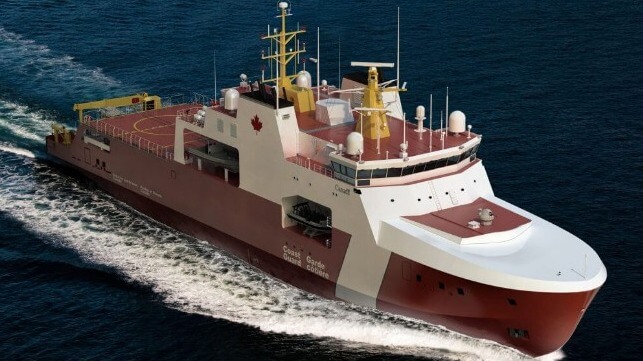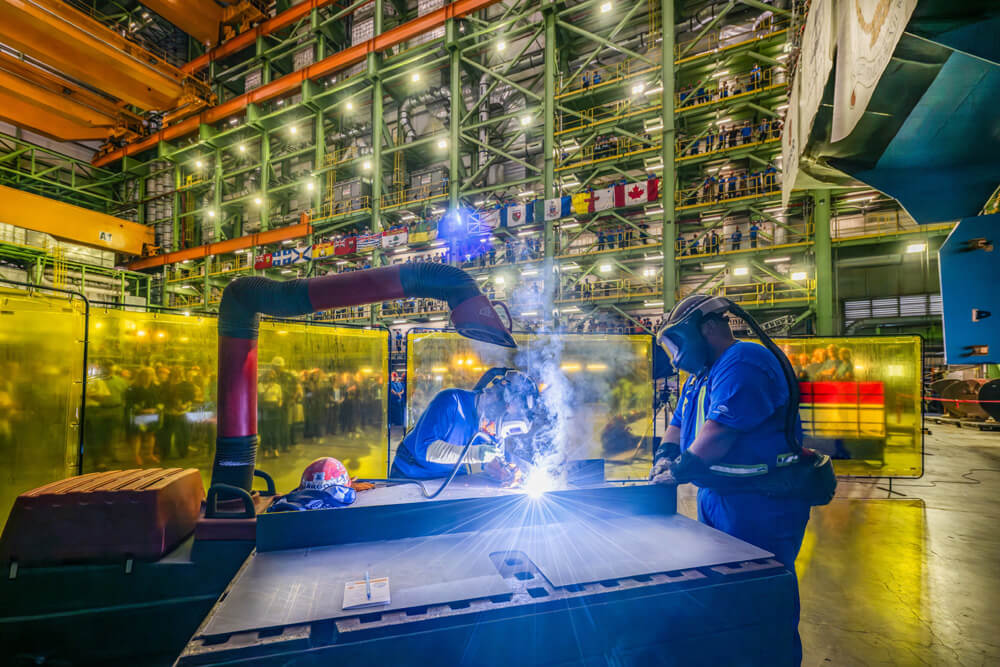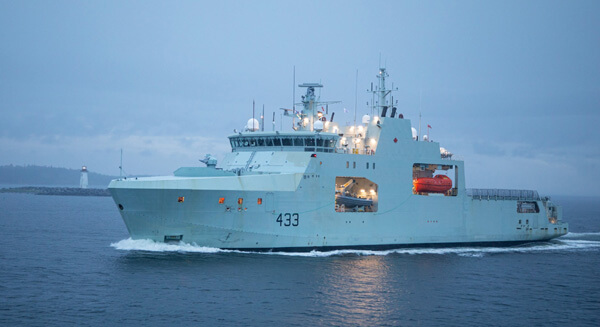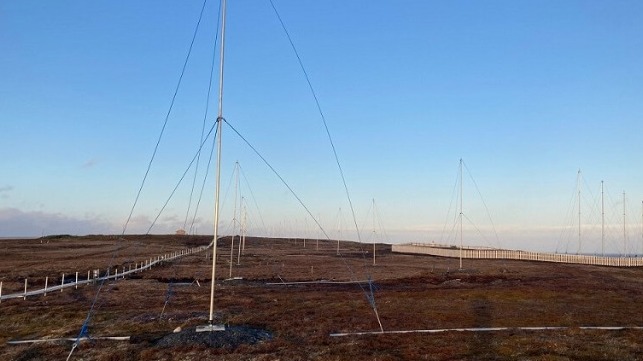Construction Starts on Canadian Coast Guard’s Arctic Patrol Ships

Work is getting underway at Canada’s Irving Shipbuilding in Halifax on the first of two new Arctic and Offshore Patrol Ships (AOPS) for the Canadian Coast Guard’s fleet. By sharing an adapted platform with the Royal Canadian Navy, they are highlighting that the vessels will allow for better cooperation between the two services while also promoting learning and skill-sharing between the crews and expanding the Coast Guard’s capabilities.
The milestone in the project was marked with a ceremonial first steel cut at the shipyard in Nova Scotia. Announced in 2022 as an extension of the contract to build six APOS vessels for use by the Royal Canadian Navy, the first of the two Canadian Coast Guard vessels is expected to be delivered in 2026. Her sistership is due in 2027 and they will replace two of the Coast Guard’s existing five Offshore Patrol Vessels. The new ships are being built under Canadian’s National Shipbuilding Strategy which is also designed to bolster the country’s shipbuilding industry.
Irving has already delivered the first three AOPS to the Royal Canadian Navy with the fourth vessel undertaking sea trials last month and expected to deliver later this summer. The mega blocks for the fifth vessel will be joined this month and the keel laying for the sixth vessel is also scheduled for this month. The fifth vessel is on schedule for delivery in 2024 followed by the sixth to the navy in 2025.
All the ships share the same dimensions with an overall length of approximately 338 feet and 6,677 metric tons displacement. The hull is designed to support icebreaking in the low Arctic during the summer and on the Canadian East Coast during the winter. They are capable of breaking one-meter first-year ice at a speed of 3 knots. The main components of the vessels, such as the hull, engines, and propulsive systems, are consistent across the class.

First steel was cut for the new ship at the shipyard in Halifax, Nova Scotia (Irving Shipbuilding)
“Our Coast Guard members are essential in keeping our waterways clean, safe, and accessible,” said Canada’s Minister of Fisheries, Oceans, and the Canadian Coast Guard, Diane Lebouthillier, during the ceremonies. “Today, as we celebrate the start of the construction of the Arctic and Offshore Patrol Ships, we are proud to invest in the Canadian Coast Guard’s fleet of the future and provide state-of-the-art equipment to our personnel.”
The Canadian Coast Guard's new Arctic and Offshore Patrol Ships will operate as a primary platform to support fisheries enforcement missions on Canada's east coast, including Northwest Atlantic Fisheries Organization patrols. They will also support search and rescue and icebreaking operations on the east coast and will be able to support environmental response and aids to navigation.
While using the same overall design, the last two vessels of the class were modified to comply with the requirements for civilian vessels and meet Canadian Coast Guard’s mission. This includes removing weapons, as well as changes to the bridge layout, the accommodations, mission spaces, the working deck, and tailoring of selected spaces for science missions including the addition of various hull-mounted sensors.

Fourth ship of the class, future HMCS William Hall, on sea trials in July 2023 (Irving Shipbuilding)
The AOPS are highly capable and versatile ships in comparison to the existing offshore patrol vessels. The new ships will be able to operate beyond 120 nautical miles including outside the Exclusive Economic Zone. They will have a top speed of 17 knots and can stay at sea for up to 48 days. They will be able to accommodate a crew of 31 and will have a total of 57 berths.
They will also be outfitted with science equipment and a medical facility to conduct scientific research and support humanitarian assistance missions. A crane and A-frame on the stern will add to the capability to support aid to navigation operations and science research. They will also have a helicopter pad and hangar that will allow the ships to accommodate both the Canadian Coast Guard’s light- and medium-lift helicopters, as well as National Defence's Cyclone helicopters. They will also be capable of loading a shipping container for resupply missions.
During the ceremonies, officials highlighted that the new vessels will be highly versatile. This will allow greater flexibility and adaptability for the Canadian Coast Guard's operations.
Opinion: Time to Increase Arctic Maritime Domain Awareness

For too long, the Canadian Arctic has not been benefitting from the attention it deserves. Yet recent events and long-term trends call for an increased security focus to the region. The geopolitical shift caused by the invasion of Ukraine by Russia and the realisation that China, which calls itself a near-arctic nation, has ambitious aspirations in the Arctic and has been conducting illegal activities in Canada for decades, call for action.
When I commanded Canadian Forces Northern Area in the late 1990s, I was appalled to learn that ships entering our internal waters were not required to report their presence to the Canadian Coast Guard (CCG). In July 2010, following years of lobbying, the Canadian Government made it compulsory for vessels of 300 tons and above entering Canadian waters to report to the Northern Canada Vessel Traffic Services Zone Regulations, better known as NORDREG. This measure significantly improved Canada’s awareness of who and what was entering our Arctic.
Unfortunately, Report Number 6 of the Auditor General of Canada (AGC) on the surveillance of Canadian Arctic Waters, published in November 2022, states that “Overall, the federal government has not taken the required action to address long-standing gaps affecting its surveillance of Canada’s Arctic waters”. Of specific concern, it also states at paragraph 6.23 that:
“The inability to reliably track, monitor, and identify non-emitting vessels, notably small vessels and those not complying with requirements on identification and tracking equipment.”
Large vessels, when operating responsibly, would normally emit information on their presence through the Automatic Identification System (AIS). This international system is designed to avoid collisions between ships. Fortunately, the AIS signals can be monitored from space and contribute significantly to maritime domain awareness. When vessels do not emit with their AIS – either due to lack of proper equipment or because they want to hide their presence - it is difficult, if not impossible, for Canada to maintain good domain awareness of maritime activity in its vast arctic internal waters and Exclusive Economic Zone.
If Canada is serious about improving its arctic maritime domain awareness, one of the simple and inexpensive ways to do it is to increase the number of ships that are obligated to report to NORDREG, and to require them to continuously emit on AIS while in Canadian waters. As I suggested at the Canadian Maritime Advisory Council Prairie and Northern Region meeting in Québec City, on 11 May 2023:
“Amend the Northern Canada Vessel Traffic Services Zone Regulations as follows:
• That vessels of 15 tons and above be prescribed as classes of vessels for the purposes of subsections 126(1) and (3) of the Act in respect of the NORDREG Zone
• That vessels over 15 tons maintain an Automatic Identification System active while operating in the NORDREG Zone”
These requirements would result in significant benefits. All federal ministries with responsibilities in the Arctic would benefit from a more complete domain awareness. The vessels themselves would benefit from increased safety: in the case of an emergency, the Canadian Coast Guard (CCG), which manages NORDREG, would immediately know which vessels would be the closest to provide assistance. The incidence of search-and-rescue (SAR) operations could be reduced, as well as the impact on annual community resupply. Indeed, among the tasks performed by the CCG, the SAR function has a higher priority than annual community resupply. Therefore, the annual resupply of an Inuit community risks being delayed or even cancelled whenever CCG icebreakers must attend a SAR situation caused by an unprepared vessel. Any delay on the delivery increases the cost of the annual sealift resupply of arctic communities.
The Nunavut Association of Municipalities is fully supportive of the recommendation to increase the NORDREG reporting and transmitting on AIS. They are increasingly concerned with the growing number of super yachts arriving unannounced on their doorstep, entering marine protected areas, or worse: fouling their traditional harvesting area and threatening their food security.
Since the proposed changes are to the regulations, rather than to the Act, the Minister could simply direct these changes under its own authority. Those changes could not be challenged given that, under the United Nations Convention on the Law of the Sea, countries are allowed to impose restrictions to manage their marine environments provided that they are not discriminatory.
To create maritime domain awareness, there is a need for multiple sources of information, which can be cross-referenced to identify the bad players. In the case of the Arctic, this means surveillance from space and inputs from a variety of actors including our Arctic Offshore Patrol Ships (AOPS), CCG icebreakers, the Aurora long-range maritime patrol aircraft, the Canadian Rangers, Transport Canada’s National Aerial Surveillance Program, the Long-Range Identification and Tracking System, the Inuit Maritime Monitoring Program, and even concerned citizens. The multiplicity of systems provides redundancy to ensure resilience: for example, if satellites are disabled by a solar storm, Canada will not become suddenly blind.
The challenge in the vast Canadian Arctic is that surveillance is presently episodic in nature. The AOPS and CCG vessels only operate there in the summer and cover a small radius around them. The AGC report indicates that the RADARSAT Constellation, which provides space surveillance, does not have sufficient capacity, and that there will be a gap before its replacement becomes operational. It also states that similar gaps will happen in other systems over the years.
One of the ways to improve our arctic maritime domain awareness is to monitor the approaches to the Arctic Archipelago using Canadian developed high frequency surface wave radar (HFSWR). This is not a new idea. High-frequency surface-wave radars can detect vessels on the surface up to a range of 200 nautical miles. One of my clients, Maerospace, a Canadian company based in Waterloo, Ontario, is proposing the installation of three systems to provide persistent 24/7 coverage of the present main approaches to the Arctic Archipelago. The disappearance of the ice may call for a fourth system in time.
The ability to detect vessels approaching the Archipelago using these radars would allow the authorities to deny entry, confirm whether a vessel has reported to NORDREG, and corroborate whether or not it is transmitting the required AIS signal. It is said that what you cannot measure, you cannot manage.
In addition, the report of the Senate Standing Committee on National Defence identified another serious surveillance gap on page 38: “For witnesses, the main surveillance gap in the Arctic concerns the detection of threats and underwater activities. They underscored that Canada currently has no capability to detect submarines, underwater UAVs or other types of submersible systems operating in the Arctic Ocean.”
Since our submarines cannot operate safely under the ice, one economical way to perform “the detection of threats and underwater activities” could be through the use of unmanned underwater vehicle (UUV). Since the UUVs operate underwater, they could be deployed year-round, regardless of the ice cover. They would not have some of the disadvantages of sonar arrays on the seabed such as their vulnerability to damage from iceberg.
A combination of short- and long-range UUVs could be used to monitor the underwater approaches to the Canadian Arctic Archipelago. The International Submarine Engineering Explorers UUV, with a range of 300 plus kilometers, could be deployed to monitor specific choke points. The long-range UUVs, such as the HUGIN Endurance from Kongsberg, with a range of 2,200 kilometers, could be deployed from Resolute Bay or Cambridge Bay to patrol the key vulnerable passages of the Northwest Passage. The UUVs may have the ability to lie down at the bottom of those passages and silently monitor activity. They could dock into unmanned underwater facilities to recharge their batteries, upload information and download instructions. By moving from one underwater docking station to another, the UUVs could monitor all the approaches to the Arctic Archipelago. When needed, the UUVs would be commanded back to a maintenance facility for servicing.
The knowledge that UUVs are patrolling the waters of the Archipelago would be a great deterrent. In addition, while the UUVs collect national defence data, they could simultaneously be collecting scientific data, such as water temperatures, salinity, ocean currents and marine life (e.g., communications between whales).
The changes to NORDREG regulations, as well as the deployment of HFSWRs and UUVs, could quickly and significantly improve our arctic maritime domain awareness and deterrence. It is unfortunate that the lack of federal leadership on national defence, the reluctance to meet NATO minimum investment in defence, combined with the present government’s apparent disinterest in protecting Canadians, will make the implementation of those recommendations a challenge.
This article appears courtesy of Vanguard Canada and is reproduced here in an abbreviated form. It may be found in its original form here.
The opinions expressed herein are the author's and not necessarily those of The Maritime Executive.
No comments:
Post a Comment